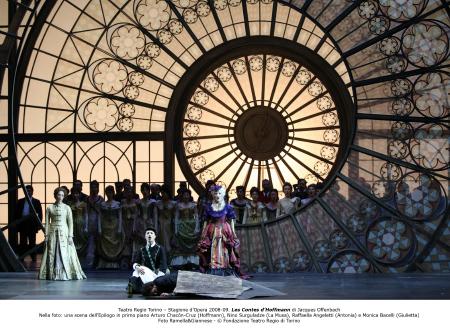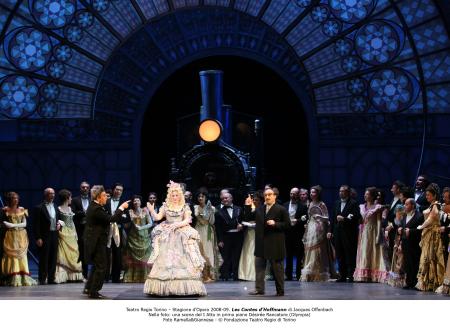Other Links
Editorial Board
-
Editor - Bill Kenny
-
Deputy Editor - Bob Briggs
Founder - Len Mullenger
Google Site Search
SEEN
AND HEARD INTERNATIONAL OPERA REVIEW
Offenbach,
Les Contes d'Hoffmann:
co-production
Teatro Real de Madrid et al, producer Nicholas Joël.
Soloists, chorus and orchestra of Teatro Regio Torino,
conductor
Emmanuel Villaume. Torino,
Italy. 4. 2.2009.
(MM)
Puzzling,
the choice of London's defunct Cyrstal Palace (1851-1936) as the
backdrop on
which all of the action of Torino's
Les Contes
d'Hoffmann took place, as was indeed puzzling
the show curtain that
was a copy of poster for a side-show - a snake covered woman
suggesting, in
English, that we see the incredible snake lady and a gargantuan gorilla
too.

Perhaps
explicable since the august Teatro Regio has not had a lot of
experience with
the complications of Offenbach's masterpiece, the last Torino Hoffmann
some thirty-five years ago. Presumably this previous Hoffmann
occurred in
1973, the first season of the controversial, then new Teatro Regio (the
previous one having burned down in 1936), whose architect, one Carlo Mollino, had obviously
never been to an
opera.
If
stage director Nicolas Joël and his designer Ezio
Frigerio did seem to be off-track in their solutions, at
least the
Teatro Regio was mostly right-on with its singers and, particularly,
with its
conductor, Emmanuel Villaume.
After all, as
we were told by the charming young guide who showed us the theater that
afternoon, opera is only music, i.e. singing. Suspicions were
that it was
going to be just that anyway.

Poor
Hoffman was left lying on the forestage in front of the show curtain
during the
five-minute transition from Luther's tavern to Spalazini's workshop (a
window
panel of the Crystal Palace
was replaced by a
full-size choo-choo train locamotive). Young Mexican tenor
Arturo
Chacón-Cruz was singing his first Hoffman in these Torino
performances.
He is in the Carreras mold, the force of his sound heaved from his body
rather
than floated from his head. His voice never faltered through
these five
demanding scenes, his final prayer to the muse offered vocally rather
than
dramatically. This young tenor made his debut only in 2006,
and to date
has been heard primarily on important American stages. While
he boasts
considerable youthful vocal splendor he still offers only the promise
of a real
Hoffmann -- we need to wait until he has lived long enough to survive a
few
brutal love affairs of his own.

There
were some tense moments as Olympia spun around the stage on a remote
controlled
platform, and these movements contributed to this heroine taking the
prize for
the best performance of the three sopranos Torino used for this
production. Had Italian soprano Désirée Rancatore been left
on her own
she might have done as all the others did, simply stand downstage to
deliver
her role. As it was she ably delivered the vocal fireworks of
her
stand-alone showpiece while whirling around the stage, marred only by
some
shattering of tone in her above-the-staff
coloratura.
In
the Antonia act the choo-choo train was replaced by a pipe organ, the
purpose
of which, we learned, was to hide Antonia's mother from view.
Center
stage there were three instruments of a vaudeville orchestra.
Young
soprano Raffaella Angeletti gave us a fine, light voiced Antonia, even
her slim
figure could perhaps have been thought of as consumptive. She
pulled out
all her considerable stops for the big trio, though she had to compete
with the
vaudeville orchestra that came alive as performing skeletons.
Not
to mention the mechanical gondoliers that propelled a couple of
gondolas into
the Crystal Palace for the Venice episode (at least there was a lot of
dark
blue light). Giulietta
was sung by
soprano (the program calls her a mezzo), Monica Bacelli, who flounced
about the
stage as if she were a naive Carmen or a silly Donna Elvira rather than
a femme
fatale, though she delivered her scene with vocal finesse,
giving
considerable pleasure as the voice of Giulietta.
The
only disappointment was basso Alfonso Antoniozzi who failed to cut the
sizeable
figures required by Offenbach's four villains, nor did he bring these
flashy
roles alive vocally, perhaps due to a flu that had forced him to cancel
the
first two performances.
Nicklausse
was a victim of her costume (though all the other costuming seemed
reasonable). She appeared first as a Salvation Army rescuer,
in something
like a brass button uniform with an apron, and a small keg hanging over
her
shoulder. For the three episodes she became a man dressed in
tails, but
reappeared at the end again as the Salvation Army nurse turned
muse. Nino
Surguladze (a Georgian, thus the possible gender confusion) made this
role very
present, providing a mezzo
soprano vocal force
that was formidable, and bringing unusual physical liveliness to
Nicklausse. She was not able to muster the stature that the
muse needs to
end the opera effectively.
The
Nicolas Joël production was evidently about mechanical things, the 1851
Crystal
Palace a symbol of the mechanical technologies that were central to an
industrial revolution. With this idea pounded into our heads
throughout
the evening the fast tempos and the lightness imposed by French
conductor
Emmanuel Villaume seemed at first vapid and
mechanical. Mr. Joël's
stage tricks had served only to trivialize these three tales, thus the
purely
musical values emerging from the pit, values that strove to balance the
overwrought emotions of the libretto with the Offenbach muse, were
overwhelmed.
It
became apparent finally that maestro Villaume was walking the line
between
operatic parody and real opera, and between operetta and opera, a line
that
this maestro apparently finds to be very fine in Offenbach's
masterpiece.
The tempos and lightness did indeed make bona fide Offenbach music, if
not the
musically indulgent Hoffmann that we
self-indulgently crave.
Nicolas
Joel is said to have been ill, and unable to come to Torino to stage
the
singers, this task taken on by Stephane Roche. In short, Mr.
Roche lined
the singers up across the stage, and made a semi-circle of the chorus
behind
them. The appearance of Stella in the final scene was the
epitome of directorial
ineptitude.
The
program booklet did not credit the edition used, though presumably it
was the
2003 Keck version, complete with the twenty-six pages of recently
discovered
manuscript for which Mr. Keck is said to have paid 160,000 euros to the
French
government.
Michael
Milenski
Pictures ©
Teatro Regio Torino
Back
to Top
Cumulative Index Page
